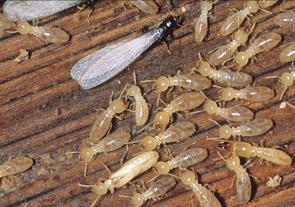If you live in and around Moreno Valley and Riverside, we invite you to call for expert termite inspection services and subterranean termite treatment. We can determine what type of termite you’ve been infested with and will have the proper treatments to get rid of the problem quickly.
In some cases, termites are confused with a carpenter or flying ants. If that’s the case, you’ll learn the difference and there won’t be any harm done. If you do have an infestation of termites, you’ll be glad that you took action, because there might already be damage to the interior of your home.

Subterranean Termite Treatment By Professional Termite Exterminators
If you notice that you have a termite infestation, you should never wait and start subterranean termite treatment and control very quickly. These termites can do untold damage to buildings, such as homes, in a rapid fashion. In some cases, you might not know any damage has occurred until you begin knocking and finding those hollowed-out spaces where the termite colonies exist.
At Final Exterminators, we are familiar with all types of termites, including the Subterranean Termite. Give us a call for a free consultation in Moreno Valley and Riverside.
 Get Started Subterranea Termite Treatment Now! (800) 953 1397
Get Started Subterranea Termite Treatment Now! (800) 953 1397What Do Subterranean Termite Look Like?
These types of termites come in varying sizes. The size of the termite depends on its caste. There are Workers, Soldiers, and Swarmers. Workers are around an eighth to three-eighths of an inch. Soldiers are just as long as workers but have a larger head and powerful mandibles. Working in a colony, these insects constantly eat and their main diet is the wood and cellulose inside your home.
You can tell subterranean termites apart from other species of termites by their colors. Worker termites have cream-colored husks and are generally paler in tone. Soldiers, on the other hand, are light in color, but their heads are brown. Worker termites don’t have eyes, because they’re used to burrowing into very dark holes. Still, workers can tell the difference between light and dark. Light means danger, and so workers tend to prefer the dark and seek it out whenever they can.
As the colony of subterranean termites grows, a supplementary queen helps to lay eggs, thereby increasing the colony size even more. Swarmers, another type of subterranean termite, develop when the colony is three to five years old. These termites will leave the colony to start a new one of their own.
Where Are Subterranean Termites Found In Homes?
Subterranean termites nest in the soil. The colony exists about 12 to 18 inches below the surface. In some cases, the termites will live within the mud tubing that starts at the foundation of an infested structure. These tubes can extend behind drywall as high as the second floor.
Moisture inside the tubing allows the subterranean Termite to survive above ground while returning to the soil from time to time. These termites can do extensive damage to the foundations of homes and buildings, going so far as to compromise the structural integrity of the building.
Unfortunately, tenting and fumigating will not eliminate the infestation. Instead, you must treat the soil with a non-repellent termiticide such as Termidor or Taurus.
Subterranean Termite Treatment And Prevention
If you are constructing a new home, you can be proactive in your extermination of termites by treating the soil. You can also try termite bait station monitoring and regular inspections by a pest Inspection company like Final Exterminators.
When an infestation has occurred, the best course of action is immediate action. Termites do billions of dollars in damage to U.S. homes every year. All that wood damage can lower the value of your home and lead to expensive repairs.
You can cut down on your expenditures and frustration by trusting your pest inspection needs to the area’s best. We know termites and how to get rid of them. We can also help you assess any damage that has already been done to your home so that you can mitigate and minimize damages while getting back on the road to home renovation.
We Do Subterranean Termite Treatment And Control in Moreno Valley & Riverside, CA
Phone: (800) 953-1397
